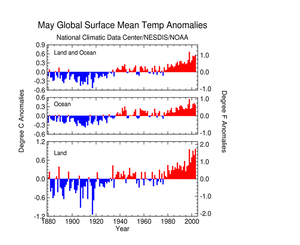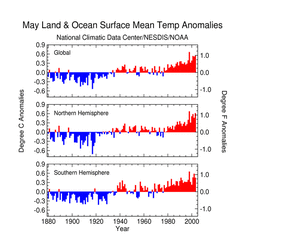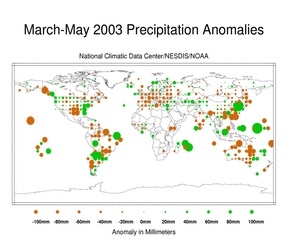Global Highlights:
- Global average combined land and sea surface temperature was
the second warmest for May 2003 and fourth warmest March-May
2003
- March-May 2003 temperatures were much above average across the
western U.S. and Europe with below average temperatures in the
northeastern U.S. and most of the Middle East
- Precipitation during March-May 2003 was above average in the
southeastern U.S. and East Asia, with drier than average conditions
over most of Australia, the lower Great Plains of the U.S. and
India
- Cooler sea surface temperatures in the central and eastern
equatorial Pacific continued to indicate development of La Nina
conditions
|
|
Contents of this Section:
|
The data
presented in this report are preliminary. Ranks and anomalies may
change as more complete data are received and processed. The most
current data may be accessed via the Global Surface
Temperature Anomalies page.
Introduction

larger image |
May temperature
anomalies calculated from the Global Historical Climatology Network
data set of land surface stations (using a 1961-1990 base period)
also show above average temperatures throughout much of Europe, the
Middle East, East Asia and Mexico. Monthly temperatures were
2-4°C (3.6-7.2°F) above the mean. Cooler than average
temperatures were present throughout the northeastern U.S. into the
Great Lakes region and the eastern coast of Australia where monthly
temperatures were as much as 1-3°C (1.8-5.4°F) below
average. |
Temperature
May
- For May 2003, the global average land and ocean
surface temperature was 0.54°C (0.97°F) above the 1880-2002
average, ranking as the second warmest May in the period of
record
- The warmest May occurred in 1998, when the global
anomaly was +0.66°C (+1.19°F)
- Globally averaged land temperatures were warmest
on record, 0.96°C (1.73°F) above the long-term mean
|

larger image |
- May 2003 temperatures averaged across the
Northern Hemisphere were second warmest on record, 0.61°C
(1.10°F) above the long term mean
- Temperatures averaged throughout the Southern
Hemisphere were fourth warmest, 0.45°C (0.81°F) above
average
|

larger image |
March-May
- For March-May 2003, the global average land and
ocean surface temperature was 0.55°C (0.99°F) above the
long term mean, fourth warmest for boreal spring.
- Ocean surface temperatures were 0.40°C
(0.72°F) above the 1880-2001 mean, third warmest for March-May
2003.
- March-May 2003 temperatures averaged across the
Northern Hemisphere were sixth warmest on record, 0.58°C
(1.00°F) above the long term mean
- Temperatures averaged throughout the Southern
Hemisphere were third warmest, 0.48°C (0.86°F) above
average
|

larger image |

larger image |
- Serial monthly global surface temperature departures with
respect to a 1971-2000 mean are shown in the figure to the
left
- Globally averaged surface temperatures (land and ocean) have
been warmer than the 1971-2000 average for the last 85 consecutive
months
|
Precipitation
- During March-May 2003, much above average
precipitation fell across the southeastern U.S., northern Argentina
and East Asia
- Below average precipitation was observed in
southern Brazil, most of Canada and the majority of Europe and
Australia
- During the month of May
2003 , unusually wet weather occurred in Scandinavia, western
Europe and the East Coast of Australia while areas of Ethiopia,
India and the Middle East experienced drier than average
conditions.
- Additional regional analysis can be found on the
Global Hazards page
|
 larger
image larger
image |
ENSO SST Analysis

Click here for animated loop |
- La Nina conditions continued to develop in May as sea surface
temperatures further cooled in the central and equatorial Pacific,
as shown in the adjacent animation of weekly sea surface
temperature anomalies. This trend as well as others, such as a
steady deepening in the central and eastern equatorial Pacific
oceanic thermocline are indicators of strengthening La Nina
conditions. The most up-to-date information on ENSO (El
Nino/Southern Oscillation) conditions can be found at NOAA's Climate
Prediction Center (CPC) and the CPC ENSO Diagnostic
Discussion
- Images of sea surface temperature conditions are
available for all months to date during 2003 at the weekly sst page
|
References:
Peterson, T.C. and R.S. Vose, 1997: An Overview of the Global
Historical Climatology Network Database. Bull. Amer. Meteorol.
Soc., 78, 2837-2849.






 larger
image
larger
image
 NOAA's National Centers for Environmental Information
NOAA's National Centers for Environmental Information
